Cyphastrea is a unique group of reef corals which are nearly ‘perfect’ residents of home reef aquariums. This primarily encrusting coral is colorful, incredibly hardy, and it grows unbelievably fast, even under a wide range of conditions.
The meteor shower Cyphastrea was the first aquarium coral strain to put this moon coral genus on the aquarium map. With a brilliant turquoise green base color and bright red mouths and corallites, the meteor shower was the first Cyphastrea that collectors had to have. Thankfully, even this color strain isn’t rare in the wild and many different wild interpretations of a ‘meteor shower’ have been imported since.

It seemed like after that, Cyphastrea had its heyday in the ‘coral fad’ scene, but the genus still has a lot of mileage left. The Purple People Eater Cyphastrea is a crowd pleaser, the Bling Bling is quite the looker, and the branching Chaos Cyphastrea decadia is rising up in the ranks as well.
But for us, the creme-de-la-creme is the incredibly brilliant strains that include the rainbow Cyphastrea and Bizarro Cyphastrea. These closely related color morphs are all part of the same species-complex, most likely the super widespread Cyphastrea serailia, which has the distinctions of having relatively large and colorful polyps.

Cyphastrea with rainbow and bizarro coloration are exceptional in appearance with brightly colored polyps that contrast vividly with a darkly colored base tissue. It’s hard to tell where one strain and the other begins, as our example of bizarro Cyphastrea has morphed quite a lot under LED lighting over the last two years with the pinkish red color from the mouth expanding and spreading out of the polyps.
Regardless of the name or the strain, Cyphastrea is a genus of coral which everyone should try to keep and grow at some point in their saltwater aquarium career. It grows really fast and looks really good under a wide range of aquarium environments, and even sometimes looks even better under reduced or moderate lighting.




